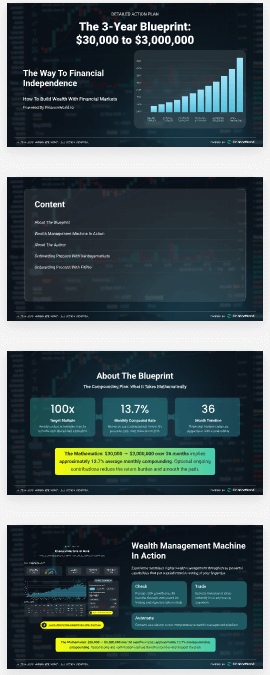Table of Contents
ToggleTeaching Intraday Trading: A Step-by-Step Approach
Introduction
In today’s fast-paced financial landscape, intraday trading has garnered immense popularity among investors, ranging from beginners to experienced traders. This approach allows investors to capitalize on short-term price fluctuations of assets, emphasizing skill, strategy, and market insight. As more individuals seek to navigate the complexities of the financial markets, the demand for effective teaching methods in intraday trading has risen sharply.
Whether you are looking to diversify your investment strategy or aiming for quick profits, understanding the nuances of intraday trading is essential. This article provides a comprehensive, step-by-step approach to teaching intraday trading, that not only enlightens but also equips you with practical tools necessary to thrive in this challenging environment.
Understanding Intraday Trading
What is Intraday Trading?
Intraday trading refers to the practice of buying and selling stocks, commodities, or other financial instruments within the same trading day. Traders engage in this practice to capitalize on small price movements, and it requires alertness to market signals, detailed analysis, and immediate decision-making capabilities.
Why is Intraday Trading Important?
The significance of intraday trading is underpinned by several reasons:
- Liquidity: It provides high liquidity in the market, allowing traders to enter and exit positions swiftly.
- Profit Potential: Traders can benefit from price volatility, aiming for small profits accumulated throughout the day.
- Flexibility: Unlike long-term investments, intraday trading does not bind capital for extended periods, allowing for diverse investment opportunities.
Key Characteristics of Intraday Trading
To successfully engage in intraday trading, one must possess certain characteristics, including:
- Discipline: Sticking to a trading plan, regardless of emotional impulses.
- Focus: Constantly analyzing market conditions without distractions.
- Quick Decision-Making: The ability to act on information swiftly, given the fast nature of trading.
Step-by-Step Approach to Teaching Intraday Trading
Step 1: Setting Up a Trading Plan
Importance of a Trading Plan
A well-defined trading plan serves as a roadmap for your intraday trading journey. It establishes your objectives, risk tolerance, and strategy. Without a plan, traders are susceptible to emotional decisions that can lead to significant losses.
Components of a Trading Plan
- Trading Goals: Define what you want to achieve, be it daily profits, percentage gains, or a specific number of trades.
- Risk Management: Establish rules for maximum loss per trade and per day.
- Strategy: Choose a trading strategy that fits your risk tolerance and financial goals. Strategies can include scalping, momentum trading, or reversal trading.
Step 2: Selecting the Right Trading Platform
Overview of Trading Platforms
Selecting a trading platform is crucial for successful intraday trading. Factors to consider include:
- User Experience: A straightforward, intuitive interface enhances trading efficiency.
- Tools and Features: A platform should provide robust charting tools, technical indicators, and research materials for traders.
- Fees: Understand the commission structure, as high fees can erode profitability.
Recommended Platforms
Consider platforms that are consistently rated highly, offering efficient trade execution and tools tailored for intraday trading. For examples of top trading platforms, visit FinanceWorld.io.
Step 3: Understanding Market Indicators
Types of Market Indicators
Indicators serve as a critical component in analyzing price movements and forming trading strategies. Key types include:
- Volume: Measurement of the number of shares traded within a specific timeframe, indicating market activity.
- Moving Averages: This indicator smooths price data to identify trends over time.
- Relative Strength Index (RSI): An oscillator that measures the speed and change of price movements, helping traders identify overbought or oversold conditions.
Step 4: Analyzing Market Typologies
Market Types and Their Importance
Understanding market types is fundamental for effective intraday trading. Key types include:
- Bull Markets: Characterized by rising prices. Traders may exploit upward movement for buying opportunities.
- Bear Markets: Defined by falling prices. Traders may short-sell to capitalize on downturns.
- Ranges: When prices oscillate within set levels, traders aim to buy at support and sell at resistance.
Step 5: Developing a Profitable Trading Strategy
Types of Intraday Trading Strategies
- Scalping: Involves making numerous trades each day to profit from small price changes.
- Momentum Trading: Traders capitalize on stock price trends, buying securities that are trending upward and selling those that are declining.
- Breakout Trading: Traders identify key price levels and take positions when prices move beyond these lines.
Backtesting Your Strategy
Before implementation, backtest your strategy against historical data to evaluate its effectiveness. This analysis allows you to adjust parameters and refine your approach, minimizing real-time losses.
Step 6: Implementing Risk Management Tactics
Importance of Risk Management
Effective risk management can mean the difference between success and failure in intraday trading. Techniques include:
- Stop-Loss Orders: Automatically sell a position when it reaches a specified price to mitigate losses.
- Position Sizing: Determine how much capital will be allocated to each trade based on account size and risk tolerance.
- Risk-Reward Ratio: Establishing a favorable ratio—typically, a 1:2 risk-reward ratio means risking $1 for the potential to earn $2.
Step 7: Execution and Trade Management
Steps to Execute a Trade
- Prepare: Gather market data and set alerts for entry points.
- Monitor: Track your trades closely to respond to market developments.
- Review: Analyze the trade post-execution to understand successes and pitfalls.
Step 8: Continuous Education and Adaptation
Commitment to Learning
The financial markets are always evolving, necessitating that traders continuously update their knowledge and adapt strategies. Resources include:
- Books: Titles by acclaimed traders provide insights into techniques and philosophies.
- Online Courses: Various platforms offer structured learning on intraday trading strategies.
- Trading Communities: Engaging with fellow traders can provide support, insights, and new strategies.
Practical Tips and Strategies for Intraday Trading
Tips for Success
- Stay Updated: Regularly follow financial news and reports to grasp market trends.
- Keep a Trading Journal: Documenting trades will help analyze your performance over time, identifying strengths and weaknesses.
- Practice with a Demo Account: Utilize demo accounts to practice trading strategies without financial risk.
Common Mistakes to Avoid
- Overtrading: Attempting more trades than your strategy allows can dilute your effectiveness.
- Ignoring Fees: Allocation of profits must factor in trading fees and taxes.
- Neglecting Market Sentiment: Emotional decision-making can lead to disastrous trades; keep logic and strategy at the forefront.
Conclusion
Teaching intraday trading involves understanding its essence and effectively disseminating knowledge through structured steps. From formulating a trading plan to selecting a platform and maintaining rigorous risk management practices, each step is integral for successful trading outcomes.
By employing the strategies and tips discussed, traders can foster a more disciplined and informed approach, maximizing profit potential while minimizing potential pitfalls.
As you embark on your intraday trading journey, remember to continuously educate yourself and adapt your strategies to the changing market landscape. Whether you’re starting or refining your skills, platforms like FinanceWorld.io are invaluable resources for tools and insights that support your trading endeavors.
Engage and Share
Did you find this article helpful for your intraday trading education? What tips or strategies would you recommend to others? Share your thoughts in the comments below and join the conversation about effective trading practices!
Feel empowered to explore more financial tools and products at FinanceWorld.io, whether it’s trading signals, automated trading solutions, or advanced trading platforms. Unleash your potential today!




